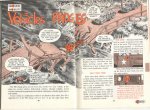Well I should've known, that seems like a real dumass way to figure weight classifications.
It kind of does at first, but there is more to what a bridge can carry than just weight. The wheel base, and the distance between individual axles will determine how many of the structural supports below the bridge will be bearing what percentage of the weight of which axle at any given instance. The more structural members the weight can be divided among at any given time, the more the bridges capacity will be. The more tires there are to divide the weight, the less strength in the bridges decking will be required to transfer that weight to the structural members. Structural capacity is not a simple measurement by any means. The bridge plate idea is to greatly simplify that.
As for letting drivers decide...
Yeah, sure. Bridges look a lot stronger in adverse circumstances. Really they would have two choices.
They'd have to train drivers with algebra, trig, calculus, material properties, bridge construction technique for every bridge ever invented, how to identify them on the fly, and make them good enough at it that they could work out what they need to know on a case by case basis...
Or they would have to rate the bridge at a single weight for the shortest, narrowest vehicle that would ever cross it in the course of it's designed lifetime. In which case the bridge would have a weight rating, depending on the type and construction, that could be anywhere from 30 to 60 percent of it could carry with more wheelbase, more wheels, etc. Floating bridges are even worse. That would be a LOT of infrastructure, manpower, and delays to provide that much overkill on a portable basis, as many of the bridges in question are.







